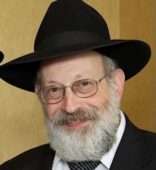The 90,000-plus Jewish men, women and children who are expected to converge on MetLife Stadium in East Rutherford, N.J., on New Year’s Day won’t be watching a football game. The stands and field will be filled with people celebrating Jewish study, specifically that of the Babylonian Talmud, the millennia-old seminal text of Jewish law and lore.
But they will also be doing something else: Revealing a path to Jewish unity.
The attendees of the Thirteenth Siyum HaShas, or “Completion of the Talmud,” will have traveled from across the tri-state area and across the continent — although simultaneous gatherings will be taking place too in Mexico, South America and cities in Israel and Europe. Bringing them together is the latest once-in-seven-and-a-half-year culmination of the Talmud study program known as Daf Yomi.
Those Hebrew words mean “a two-sided page a day,” and that is the rate at which the program’s tens of thousands of participants study the entirety of the Babylonian Talmud.
A page a day might not seem terribly daunting, but anyone familiar with Talmud knows that a single phrase or inscrutable comment can easily be the subject of dozens of commentaries, that the material is written in a form of ancient Aramaic, lacks all punctuation and can be unnervingly complex.
And so, to stay with the program, Jews around the world set aside an hour or so — some, several hours — each and every day of those seven-and-a-half years to study the very same page of Talmud.
The Daf Yomi program was introduced by a young rabbi named Meir Shapiro in 1923. No one knows how many Jews celebrated the first or second Siyum HaShas. But, amazingly, right after the Holocaust, in 1945, thousands in the Feldafing Displaced Persons camp, in what would in three years become Israel, and in New York City, marked the third such celebration. More recent Siyum HaShas celebrations have been, as the upcoming one will be as well, dedicated to the memory of the Jews murdered in the Holocaust.
The celebration is organized by Agudath Israel of America, the national organization that I serve as public affairs director. The 1968 event drew about 300 people in Brooklyn; by 1975, at the 7th Siyum HaShas, over a thousand celebrants gathered at the Manhattan Center. By 1990, the celebration filled Madison Square Garden’s 20,000 seats. In 1997, the Siyum HaShas required both The Garden and the similar-sized Nassau Coliseum.
And at the most recent 12th Siyum HaShas, in 2012, celebrants filled MetLife Stadium and other venues across the continent and the world.
While the celebration’s focus is the importance of Jewish study, the event’s deeper import is how powerfully unifying such study can be.
Contrary to many people’s assumption, the Orthodox community is a widely variegated one. It encompasses chasidic, Centrist and “Yeshivish” elements — and each of those groups is itself comprised by distinct, and often very different, subgroups. Few things bring so many of all those disparate elements tightly together. Daf Yomi is one.
While the great majority of those who will be attending the Siyum are Orthodox, pronounced efforts were made by the organizers to have Jews of all persuasions join the Siyum, and many in fact will be in attendance. Countless others will have the opportunity to access a webcast of the event, with — replacing any speeches delivered in Yiddish — special addresses geared for a more general audience.
So very much divides Jews today, whether in the realms of Jewish belief, Jewish observance, social issues or politics.
According to Jewish tradition, the epitome of Jewish unity was attained at the foot of Mount Sinai, when we stood, as the Torah states, “as one person, with one heart” to receive the Torah.
The study of Torah — which today includes a wealth of Jewish texts — remains a potent unifier of Jews. That fact is borne out by the experience of programs like Partners in Torah (https://www.partnersintorah.org/) and TorahMates (https://torahmates.org/), which match pairs of Jewish men and of Jewish women from diverse parts of the Jewish world’s spectrum to study and discuss whatever Jewish text they choose, weekly, by telephone or Skype.
Some such chavruta — or “partnered” — study focuses on the text of the Chumash, the Jewish Bible, or the Prophets or Writings portions of Jewish holy writ. Other study partners choose older or contemporary works on aspects of Jewish observance or ethics. Others, still, opt for works of mussar, or spiritual development, or on Jewish thought.
The goal of such programs is not to proselytize, only to foster knowledge of the sources of Jewish wisdom.
Sadly, and as many recent events have shown, the only thing that seems to unite all Jews has been something lamentable and ugly: anti-Semitism.
The sight of nearly a hundred thousand Jews joining together to celebrate Jewish learning should impel us all to recognize a positive path that holds the potential of bringing us closer to one another.
Rabbi Avi Shafran serves as Agudath Israel of America’s director of public affairs.
The New York Jewish Week brings you the stories behind the headlines, keeping you connected to Jewish life in New York. Help sustain the reporting you trust by donating today.





